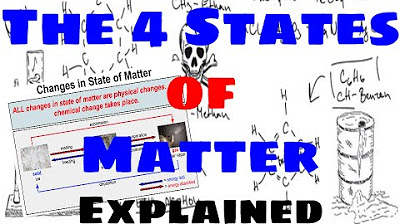KALOR DAN PERUBAHAN WUJUD | KALOR DAN PERPINDAHAN KALOR
Summary
TLDRThis video explains the fundamental physics concepts related to the three states of matter—solid, liquid, and gas—and how they undergo phase transitions like melting, freezing, vaporizing, and condensing. It discusses how heat (calor) plays a critical role in these transitions, with specific attention to latent heat, including fusion, freezing, vaporization, and condensation. The video explores how different substances change states at certain temperatures and the energy required for these processes. Viewers are guided through formulas for calculating the heat involved in phase changes, with practical examples for better understanding.
Takeaways
- 😀 The three primary states of matter are solid, liquid, and gas, and these can change between each other through processes like melting, freezing, evaporation, condensation, and sublimation.
- 😀 Changes in the state of matter occur due to the absorption or release of heat energy, affecting the substance's temperature and physical state.
- 😀 A substance will change from solid to liquid (melting) when it reaches its melting point, and from liquid to gas (boiling) when it reaches its boiling point.
- 😀 Heat plays a crucial role in the phase changes of matter. For example, melting requires heat input, while freezing releases heat.
- 😀 Melting and freezing are related to the concept of latent heat. Latent heat of fusion refers to the heat required to convert a solid into a liquid, and latent heat of freezing refers to the heat released when a liquid freezes into a solid.
- 😀 The process of freezing involves cooling a substance, causing it to release heat and transition from liquid to solid.
- 😀 The amount of heat required to melt or freeze a substance is proportional to its mass and the specific latent heat value for the material.
- 😀 The formula for calculating the heat required or released during phase changes is Q = m * l, where Q is the heat, m is the mass, and l is the latent heat of fusion or freezing.
- 😀 Vaporization (evaporation) requires heat input and is governed by the latent heat of vaporization, while condensation releases heat and involves the transition from gas to liquid.
- 😀 The latent heat of vaporization and condensation are also related. The amount of heat required to evaporate a liquid is the same as the amount of heat released during condensation, and both depend on the mass of the substance.
Q & A
What are the three basic states of matter mentioned in the script?
-The three basic states of matter are solid, liquid, and gas.
How can matter change from one state to another?
-Matter can change from one state to another through processes such as melting, freezing, evaporating, condensing, crystallizing, and sublimating.
What causes the change in the state of matter?
-The change in the state of matter is caused by the absorption or release of heat, which affects the temperature of the substance.
What is the significance of the freezing and boiling points in the changes of state?
-The freezing point and boiling point are the temperatures at which a substance transitions from one state to another, such as from liquid to solid (freezing) or from liquid to gas (boiling).
What is the relationship between heat and the changes in the state of matter?
-Heat is necessary to either melt or vaporize a substance, while it is released during freezing or condensation. The temperature of the substance must reach specific points for the state change to occur.
What happens during the process of melting?
-During melting, a solid substance absorbs heat and changes into a liquid, such as ice turning into water.
Does freezing require heat or release heat?
-Freezing releases heat. For example, when water is placed in a freezer, it loses heat and becomes solid (ice).
What is latent heat of fusion and latent heat of freezing?
-Latent heat of fusion is the amount of heat required to melt a substance, while latent heat of freezing is the heat released when a substance freezes. These values are the same for a substance but occur in opposite processes.
What is latent heat of vaporization and condensation?
-Latent heat of vaporization is the heat required to change a liquid into gas, and latent heat of condensation is the heat released when gas turns back into liquid.
How are the heat values for different phase changes represented in formulas?
-For phase changes, heat is calculated using the formula Q = m * L, where Q is the heat required or released, m is the mass of the substance, and L is the latent heat value (latent heat of fusion, vaporization, etc.).
Outlines

Этот раздел доступен только подписчикам платных тарифов. Пожалуйста, перейдите на платный тариф для доступа.
Перейти на платный тарифMindmap

Этот раздел доступен только подписчикам платных тарифов. Пожалуйста, перейдите на платный тариф для доступа.
Перейти на платный тарифKeywords

Этот раздел доступен только подписчикам платных тарифов. Пожалуйста, перейдите на платный тариф для доступа.
Перейти на платный тарифHighlights

Этот раздел доступен только подписчикам платных тарифов. Пожалуйста, перейдите на платный тариф для доступа.
Перейти на платный тарифTranscripts

Этот раздел доступен только подписчикам платных тарифов. Пожалуйста, перейдите на платный тариф для доступа.
Перейти на платный тарифПосмотреть больше похожих видео

Phase Diagrams and the States of Matter

SCIENCE 7: Quarter 1-LC 5: PHASE CHANGES OF THE STATES OF MATTER| MATATAG CURRICULUM

Wujud Zat dan Perubahannya | IPAS Kelas 4 Kurikulum Merdeka

CHANGES IN STATES OF MATTER || FREEZING, MELTING, CONDENSATION, EVAPORATION, SUBLIMATION, DEPOSITION

Matéria e energia [Módulo 01_Aula 01]

The Four States of Matter - Explained
5.0 / 5 (0 votes)
